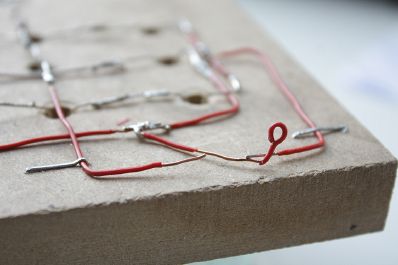Lydiakluge (talk | contribs) |
Lydiakluge (talk | contribs) |
||
| Line 12: | Line 12: | ||
[[File:Led-zero-one-two-way-connection.gif|800px]] | [[File:Led-zero-one-two-way-connection.gif|800px]] | ||
'' | To accomplish the change of the number we build a two-way connection; first we put one, two and two times three LEDs each in a series circuit and connected those in parallel. Next a resistor of 330 Ohm was used for the wiring with only one LED and a resistor of 220 Ohm for the one with two LEDs. That's slightly more resistance than needed but we assumed this wouldn't be a problem. | ||
On top of this we improvised a toggle switch which connects the two LEDs either with the single LED to form the "1" or with the other six LEDs to form the "0". | |||
[[File:Led-zero-one-two-way-connection-back.jpg|800px]] | |||
[[File:Led-zero-one-two-way-connection-switch1.jpg|398px]] | |||
[[File:Led-zero-one-two-way-connection-switch2.jpg|398px]] | |||
'''Circuit Diagramm''' | |||
[[File:Led-zero-one-two-way-connection-circuit.jpg|800px]] | |||
Revision as of 23:00, 6 February 2014
Get That Soldering Done
Task
The task was to build a small circuit mainly in order to familiarise ourselves with a soldering iron.
Work
Tobias Wolf and I constructed a wooden display that either shows the number zero or the number one with the help of a drilled dot matrix and nine LEDs.
To accomplish the change of the number we build a two-way connection; first we put one, two and two times three LEDs each in a series circuit and connected those in parallel. Next a resistor of 330 Ohm was used for the wiring with only one LED and a resistor of 220 Ohm for the one with two LEDs. That's slightly more resistance than needed but we assumed this wouldn't be a problem.
On top of this we improvised a toggle switch which connects the two LEDs either with the single LED to form the "1" or with the other six LEDs to form the "0".
Circuit Diagramm



